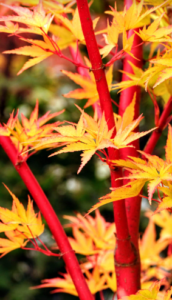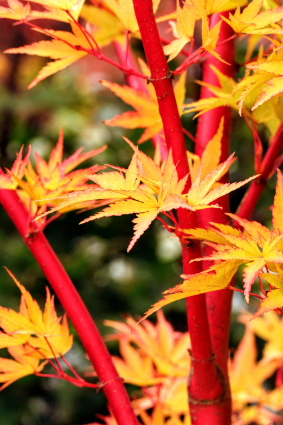Sangu Kaku

Sango Kaku, also known as the Coral Bark Japanese Maple, is a beautiful and popular ornamental tree that is highly valued for its striking coral-red bark, especially in the winter months. It is a deciduous tree that originated in Japan and is a member of the Aceraceae family. It is a small to medium-sized tree that can grow up to 20 feet tall with a spread of 15-20 feet. Its leaves are light green in spring and summer, turning yellow in autumn. In this article, we will discuss the various aspects of Sango Kaku, including its landscaping ideas, and how to plant, prune, water, fertilize, grow, maintain, and care for it.
USDA Zone
Sango Kaku can grow in USDA Zones 5-8, where the temperature ranges from -20°F to 20°F.
Sango Kaku Requirements
Before planting a Sango Kaku, it is essential to consider its needs to ensure that it thrives in your garden. Some of the crucial needs of this tree are as follows:
- Soil: Sango Kaku thrives in well-drained soil that is rich in organic matter. It prefers slightly acidic to neutral soil with a pH between 5.5 and 7.0. The soil should be moist but not waterlogged.
- Light: This tree thrives in partial shade to full sun. However, it is essential to protect it from the hot afternoon sun in the summer months as it can scorch the leaves.
- Water: Sango Kaku requires regular watering, especially during the first few years after planting. The soil should be kept moist but not waterlogged. In hot weather, it may require watering more frequently.
- Temperature: This tree can tolerate cold temperatures, but it should be protected from the hot afternoon sun during the summer months.
Landscaping ideas
Sango Kaku is a versatile tree that can be used in various landscaping ideas. Some of the landscaping ideas are:
- Focal point: The Sango Kaku’s striking coral-red bark makes it an excellent focal point in any garden. It can be planted as a standalone tree or in a group to create a stunning effect.
- Accent: The Sango Kaku can be used to accentuate a water feature or a rock garden. Its vibrant foliage and bark will add color and texture to any landscape.
- Hedge: Sango Kaku can be used to create a low hedge or a screen. Its compact size and slow growth rate make it an excellent choice for creating a boundary.
- Container planting: Sango Kaku can be planted in a container and used to decorate a patio or a balcony. It is an ideal tree for urban gardening.
Planting Sango Kaku
It can be planted in spring or fall when the soil is workable. Here is a step-by-step guide to planting Sango Kaku:
- Choose a location that provides partial shade to full sun and has well-drained soil.
- Dig a hole that is twice as wide and as deep as the root ball.
- Loosen the soil at the bottom of the hole and mix it with compost.
- Place the tree in the hole and backfill it with soil, making sure that the top of the root ball is level with the ground.
- Water the tree thoroughly.
Pruning Coral Bark Japanese Maple
Pruning is essential to maintain the shape and health of Sango Kaku. It is best to prune it in late winter or early spring before the leaves emerge. Here are some tips for pruning Sango Kaku:
- Remove any dead or diseased branches.
- Remove any branches that are crossing or rubbing against each other.
- Cut back any long branches that are spoiling the shape of the tree.
- Thin out any overcrowded branches to improve air circulation.
- If you want to maintain the size of the tree, you can selectively prune the tips of the branches.
Watering
Sango Kaku requires regular watering, especially during the first few years after planting. The soil should be kept moist but not waterlogged. In hot weather, it may require watering more frequently. Here are some tips for watering Sango Kaku:
- Water the tree deeply once a week, especially during the first year after planting.
- Use a soaker hose or drip irrigation system to water the tree slowly and deeply.
- Water the tree early in the morning or late in the evening to reduce water loss through evaporation.
Fertilizing
Sango Kaku does not require much fertilizer, but it can benefit from an annual application of slow-release fertilizer in the spring. Here are some tips for fertilizing Sango Kaku:
- Use a balanced slow-release fertilizer that is specifically formulated for trees and shrubs.
- Apply the fertilizer around the base of the tree, following the manufacturer’s instructions.
- Water the tree thoroughly after fertilizing.
Maintenance and Care
Sango Kaku is a relatively low-maintenance tree, but it does require some care to ensure that it thrives in your garden. Here are some tips for maintaining and caring for Sango Kaku:
- Mulch around the base of the tree to retain moisture and suppress weeds.
- Monitor the tree for signs of pests and diseases, such as aphids, scale, and powdery mildew.
- Protect the tree from strong winds and heavy snowfall by staking it or tying it to support.
- Remove any fallen leaves and debris from around the tree to prevent the buildup of pests and diseases.
Conclusion
Sango Kaku is a beautiful and versatile tree that can add color and texture to any garden. It is relatively low maintenance and can be used in various landscaping ideas, including as a focal point, accent, hedge, or container planting. When planting Sango Kaku, it is essential to consider its needs, including soil, light, water, and temperature. Pruning, watering, fertilizing, and maintaining are also essential to ensure that the tree thrives in your garden. By following these tips, you can enjoy the beauty of Sango Kaku for many years to come. Read more blogs here.

